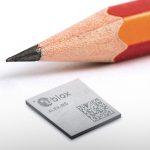Q: Will I need a new antenna for the new GPS and Galileo signals? Will one antenna work for both systems?
A: To answer these questions, information will be presented on the GPS and Galileo signal formats, some antenna basic fundamentals with various user applications in mind, followed by some predicted performance assessment.
Q: Will I need a new antenna for the new GPS and Galileo signals? Will one antenna work for both systems?
A: To answer these questions, information will be presented on the GPS and Galileo signal formats, some antenna basic fundamentals with various user applications in mind, followed by some predicted performance assessment.
The well known “Basic GPS” signals are centered at L1 (1575.42 MHz) and L2 (1227.60 MHz), with the GPS Coarse/Acquisition (C/A) code, at a chipping rate of 1.023 Mcps (million chips per second) on L1. The Precise (P) code is transmitted with a chipping rate of 10.23 Mcps on L1 and L2; if encrypted, it is then called the P(Y) or Y-code when broadcast at the 10.23 Mcps rate.
For these binary phase shift key (BPSK) modulated signals we often use the null-to-null bandwidth (twice the chipping rate) to characterize the signal bandwidth, which is 2.046 MHz and 20.046 MHz for the C/A and P(Y) codes that are transmitted in phase quadrature, respectively. Note that for many high performance applications we often require additional signal bandwidth to include the power in the sidebands of the signal spectrum. This is a very important factor in considering antenna bandwidth for a particular application.
(For the rest of Dr. Chris Bartone’s answer to this question, please download the complete article using the PDF link above.)
Q: How will the new frequencies in GPS and Galileo affect carrier phase ambiguity resolution?
A: In the years to come, GNSS users will benefit from the availability of more satellites and signals with the coming of Galileo and the modernization of GPS. Galileo will consist of a brand new constellation of 30 satellites transmitting their signals on four frequencies. Four different navigation services will be offered, meaning that some of the signals and information is available for free to every user, but other services are either to be paid for or are only available to certain authorities.
The first milestone for GPS modernization is the availability of the L2C code for civil users. In the next phase, the L5 signal will also be available.
GNSS positioning will thus be possible with improved precision, reliability, availability and integrity. Still, for rapid and high precision positioning, carrier phase ambiguity resolution remains indispensable. Only with the ambiguities fixed to their correct integer values do the carrier phase observations start to act as very precise pseudorange observations. This implies that the probability of correct integer estimation, generally referred to as the success rate, should be very close to unity.
(For the rest of Sandra Verhagen’s answer to this question, please download the complete article using the PDF link above.)
Q: Aside from E-911 and E-112, how is GNSS used in cellular telephone systems?
A: While mobile positioning for E-911 and E-112 emergency services are becoming more pervasive, other important applications of GNSS exist that are less obvious. These fall into two main categories: namely, those associated with direct mobile user applications based on the mobile’s location and those associated with enhancing the performance of the overall cellular network.
A plethora of user applications based on mobile location are rapidly emerging including street map and direction finding, fleet position data logging and targeted advertising. No dominant “killer application” has emerged at this stage, but the steady accumulation of these minor location-sensitive services is rapidly making GNSS an indispensable component of cellular functionality and markets.
The other main application category of GNSS in cellular telephony is associated with the enhancement of the overall performance of the wireless network infrastructure from the perspective of network capacity and quality of service. First-generation cellular wireless systems were based on time division or frequency division multiplexing.
(For the rest of Dr. John Nielsen’s answer to this question, please download the complete article using the PDF link above.)





